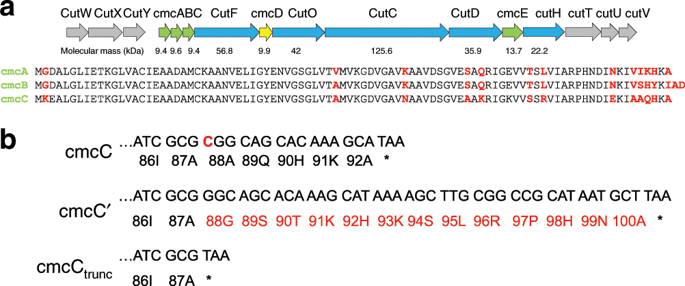当前位置:
X-MOL 学术
›
Nat. Commun.
›
论文详情
Our official English website, www.x-mol.net, welcomes your feedback! (Note: you will need to create a separate account there.)
Encapsulation mechanisms and structural studies of GRM2 bacterial microcompartment particles.
Nature Communications ( IF 16.6 ) Pub Date : 2020-01-20 , DOI: 10.1038/s41467-019-14205-y Gints Kalnins 1 , Eva-Emilija Cesle 1 , Juris Jansons 1 , Janis Liepins 2 , Anatolij Filimonenko 3 , Kaspars Tars 1, 4
Nature Communications ( IF 16.6 ) Pub Date : 2020-01-20 , DOI: 10.1038/s41467-019-14205-y Gints Kalnins 1 , Eva-Emilija Cesle 1 , Juris Jansons 1 , Janis Liepins 2 , Anatolij Filimonenko 3 , Kaspars Tars 1, 4
Affiliation

|
Bacterial microcompartments (BMCs) are prokaryotic organelles consisting of a protein shell and an encapsulated enzymatic core. BMCs are involved in several biochemical processes, such as choline, glycerol and ethanolamine degradation and carbon fixation. Since non-native enzymes can also be encapsulated in BMCs, an improved understanding of BMC shell assembly and encapsulation processes could be useful for synthetic biology applications. Here we report the isolation and recombinant expression of BMC structural genes from the Klebsiella pneumoniae GRM2 locus, the investigation of mechanisms behind encapsulation of the core enzymes, and the characterization of shell particles by cryo-EM. We conclude that the enzymatic core is encapsulated in a hierarchical manner and that the CutC choline lyase may play a secondary role as an adaptor protein. We also present a cryo-EM structure of a pT = 4 quasi-symmetric icosahedral shell particle at 3.3 Å resolution, and demonstrate variability among the minor shell forms.
中文翻译:

GRM2细菌微隔室颗粒的封装机理和结构研究。
细菌微区室(BMCs)是由蛋白质壳和封装的酶核心组成的原核细胞器。BMC涉及多个生化过程,例如胆碱,甘油和乙醇胺的降解和碳固定。由于非天然酶也可以封装在BMC中,因此对BMC壳组装和封装过程的更好理解对于合成生物学应用可能是有用的。在这里,我们报道了肺炎克雷伯氏菌GRM2基因座中BMC结构基因的分离和重组表达,核心酶包封背后的机制研究以及冷冻EM对壳颗粒的表征。我们得出的结论是,酶核心以分级方式被封装,并且CutC胆碱裂解酶可能作为衔接蛋白发挥次要作用。
更新日期:2020-01-22
中文翻译:

GRM2细菌微隔室颗粒的封装机理和结构研究。
细菌微区室(BMCs)是由蛋白质壳和封装的酶核心组成的原核细胞器。BMC涉及多个生化过程,例如胆碱,甘油和乙醇胺的降解和碳固定。由于非天然酶也可以封装在BMC中,因此对BMC壳组装和封装过程的更好理解对于合成生物学应用可能是有用的。在这里,我们报道了肺炎克雷伯氏菌GRM2基因座中BMC结构基因的分离和重组表达,核心酶包封背后的机制研究以及冷冻EM对壳颗粒的表征。我们得出的结论是,酶核心以分级方式被封装,并且CutC胆碱裂解酶可能作为衔接蛋白发挥次要作用。



























 京公网安备 11010802027423号
京公网安备 11010802027423号